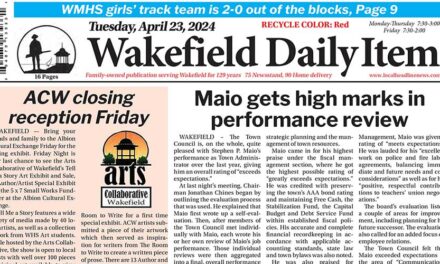Published in the October 18, 2019 edition.
By MARK SARDELLA
WAKEFIELD — Last night’s “Tri-Board” meeting at the Galvin Middle School was a kind of summit on the town’s finances, with three of the town’s top boards getting together in advance of the municipal budget season. The meeting took place in a far better fiscal atmosphere than in 2008, the last time the Board of Selectmen, the School Committee and the Finance Committee got together.
Following brief introductions, Town Council chairman Edward Dombroski moved to the “public comment” part of the agenda. He recognized Wakefield Education Association president Will Karvouniaris, who was joined by several dozen teacher’s union members seated in the Galvin Middle School Auditorium holding signs saying, “Fund Our Future.”
Karvouniaris, a Wakefield Memorial High School English and special education teacher noted that Wakefield teachers are currently working without a contract. He called the demands now placed on classroom teachers “laughable.”
“Things we need in our schools are being cut,” he said. He credited teachers union members with securing a hike in Chapter 70 funding that would only increase further with the likely passage of the Student Opportunity Act. He called on town officials to urge the House of Representatives to pass the bill, which has already received State Senate approval. He further called for “better working conditions” for teachers, including smaller class sizes in Wakefield schools. He said that funding from the Student Opportunity Act would help offset the increasing demands on teachers.
Following Karvouniaris’ speech, teachers union members stood and applauded. They filed out of the auditorium quietly about 10 minutes later, as the Tri-Board meeting moved along with its agenda.
After opening remarks from Town Council chairman Edward Dombroski, School Committee Chairman Christopher Callanan and Finance Committee Chairman Daniel Sherman, Town Administrator Stephen P. Maio offered an overview of the local budget process.
He discussed budget priorities such as public safety, roads and sidewalks, drainage, capital improvements and recreation.
Maio also reviewed the town’s financial policies, such as keeping Free Cash at 8 percent of operating revenue, maintaining the Stabilization Fund at 3 percent of operating revenue and the Reserve Fund at 0.5 percent of operating revenue.
He talked about the town’s sources of revenue and his projected amounts for FY 2021, including real estate taxes ($76 million), local receipts ($7.25 million), WMGLD payment in lieu of taxes ($932,000), state aid ($11.5 million), new growth ($2.5 million), Massachusetts School Building Authority ($529,000) and Free Cash ($1.25 million) for a total of approximately $100.2 million.
Maio then broke down the town’s projected operating costs, totaling $100,291,000.
He talked about enhancements to the budget process, including convening the Tri-Board meeting, as well as preliminary meetings between town departments and their respective liaisons from the Finance Committee and Town Council.
Callanan and School Superintendent Douglas Lyons offered an overview of Chapter 70 state aid to public education. Dombroski reviewed other types of state aid, including Chapter 90 for roads and “unrestricted” state aid.
Maio and Dombroski discussed the benefits of new growth tax revenue from new developments, construction projects and the National Grid underground transmission line project. The anticipated property tax revenue from new growth was estimated at about $1.6 million, with and added $347,000 in excise taxes. They also reviewed the financial impact of new developments on schools, public safety, traffic, public works, recreation and services to seniors and veterans. The projected increase in municipal costs from new development was projected at $0.9 million, for a net benefit of about $1 million.
Sherman and Dombroski led a general discussion of the town’s bond schedule as it related to the town’s ability to borrow for future projects, such as upgrades of the Public Safety Building and the DPW facility, cleaning up Lake Quannapowitt, road improvements and a new or renovated high school.
There was some discussion of environmental and sustainability issues, led by Maio and Town Councilor Julie Smith-Galvin.
Participants talked about ways to measure progress and success before Domroski, Callanan and Sherman offered closing remarks. The 2-hour 35 minute meeting adjourned at 9:35 p.m.




